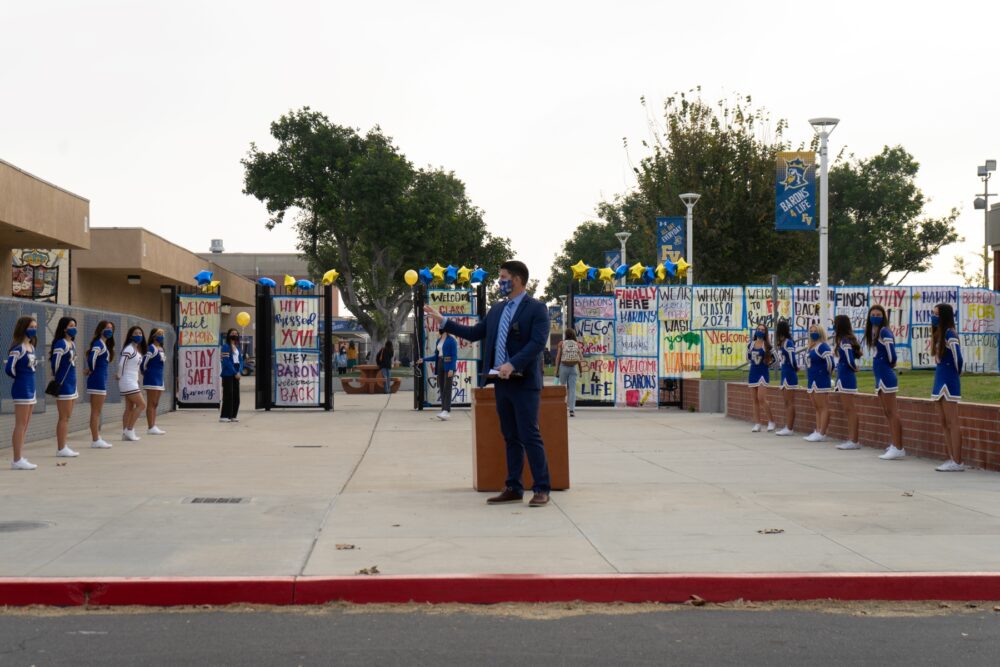
By Justin Hsieh
The first group of Fountain Valley High School hybrid students returned to campus today for their first in-person classes since March, a highly anticipated day that came after two months of distance learning at the start of the 2020-2021 school year.
“Today was a lot of fun; I think we were all more excited than we knew what to do with,” FVHS Principal Morgan Smith said. “I had that nervous energy, [but] when I saw kids coming on campus it was just like any first day of school for me, getting to say ‘hi’ and fire kids up.”
Since students and staff from special education programs first returned to campus on October 6—which Huntington Beach Union High School District (HBUHSD) Superintendent Clint Harwick said occurred “successfully and safely”—HBUHSD schools have been preparing to accept the bulk of their student bodies back onto campus.
HBUHSD’s reopening plan organizes students who elect to participate in in-person (“hybrid”) instruction into two cohorts (“teams”), which attend in-person classes either on Tuesdays and Wednesdays or on Thursdays and Fridays. Students from Team 1, who come to campus in the beginning of the week, attended their odd-numbered periods on campus today.
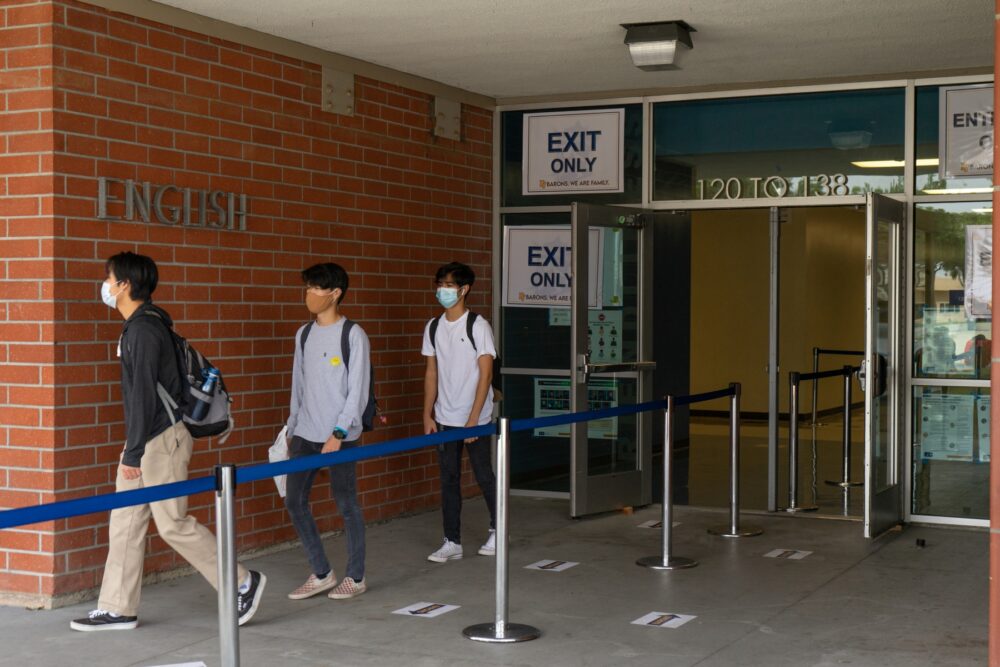
After students arrived on campus and were welcomed at the front gates by members of Pep Squad and the Associated Student Body (ASB), arrows on the ground guided them to their classes and kept foot traffic moving one-way—one of many safety precautions taken to prevent COVID-19 transmission.
“The school was very well prepared with social distancing signs and one-way arrows to prevent students from crossing paths,” senior Taylor Mendoza said.
Inside classrooms, students experienced instructional settings vastly different from traditional schooling prior to the COVID-19 pandemic. To minimize health risks, desks were separated and organized into color-coded groups, each of which was designated for a specific period. No students sat in a desk that had been occupied the previous period, and all desks that were concurrently occupied were spaced six feet apart.
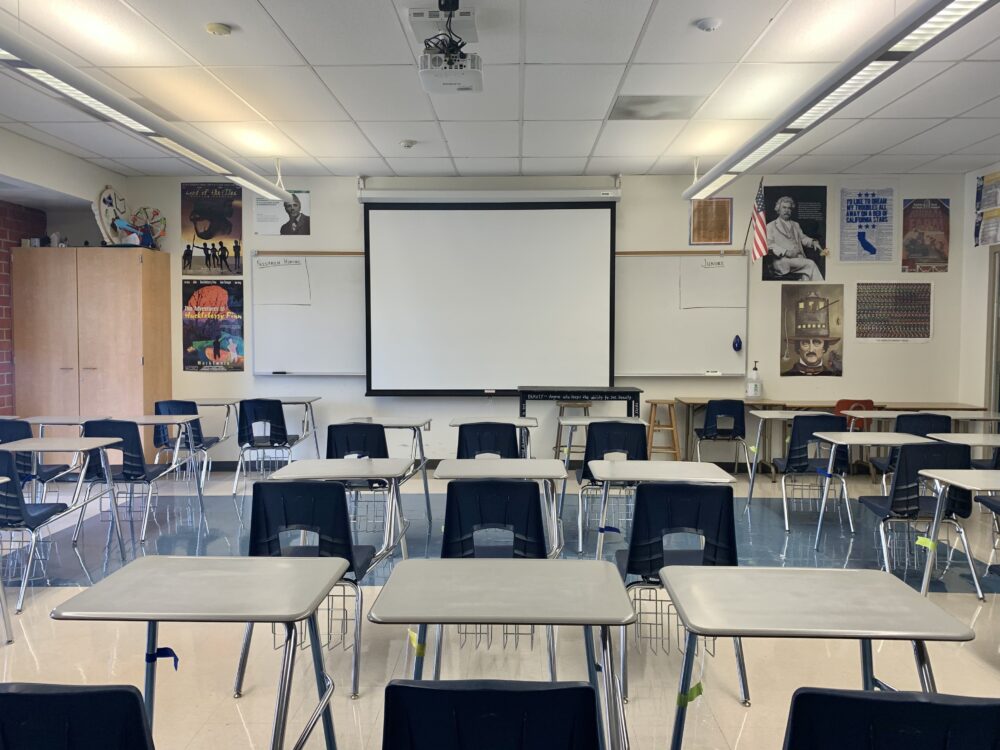
When HBUHSD first released its reopening plan in August, some community members expressed concern about the specific safety precautions that would be observed to protect students’ and teachers’ health. Although district and FVHS administrators later shared more detailed information about their safety precautions, many students and families remained uncertain about what a return to campus would look like.
Today, however, Team 1 students who attended in-person classes observed FVHS safety precautions firsthand. In addition to wearing masks at all times while on campus, students were frequently reminded by posters around campus to practice social distancing, wear masks and wash their hands, and they had access to four recently installed handwashing stations.
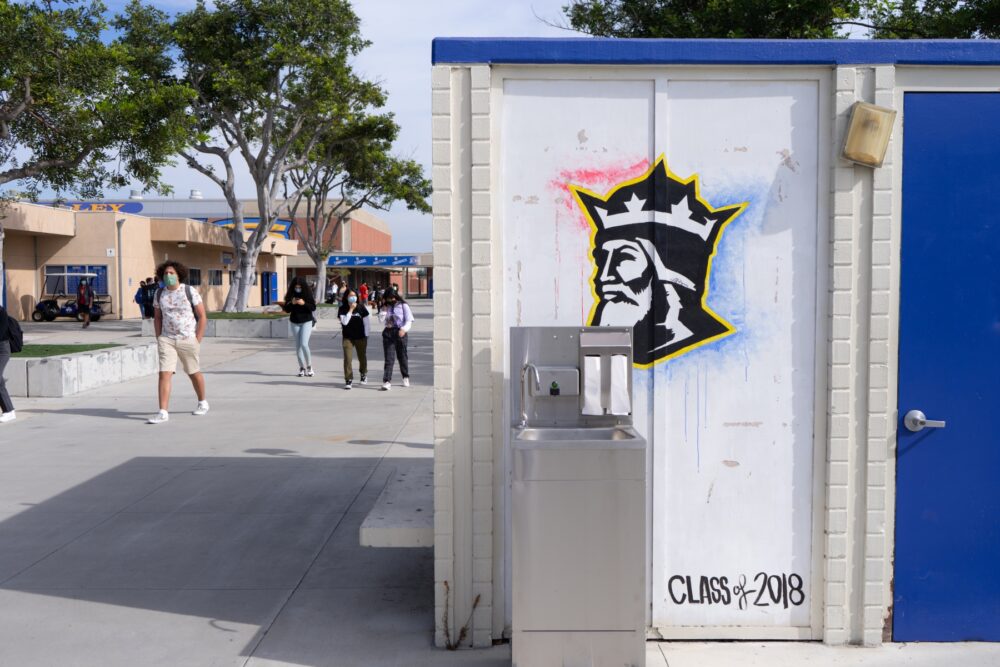
For many students, their first day of in-person instruction was a reassuring experience.
“My first impression was pretty good,” junior Matthew Bees said. “I think I was… scared because of the pandemic and school sort of mixed, but I felt very safe because we were all distanced and we all had masks on. [There] was a lot of uncertainty, but now I feel a lot more confident in going back to school.”
Dr. Smith expressed similar satisfaction with the operation of the school’s safety procedures.
“For kids that came in person today… it was easy to follow where to go, where to enter, when to exit, how to get to your classes,” Dr. Smith said. “So I think all of the kids that I talked to today were very happy that they selected hybrid; they felt very safe. They saw all of the hand-washing stations and sanitization in the classroom, so I think they felt really reassured that they made the right decision.”
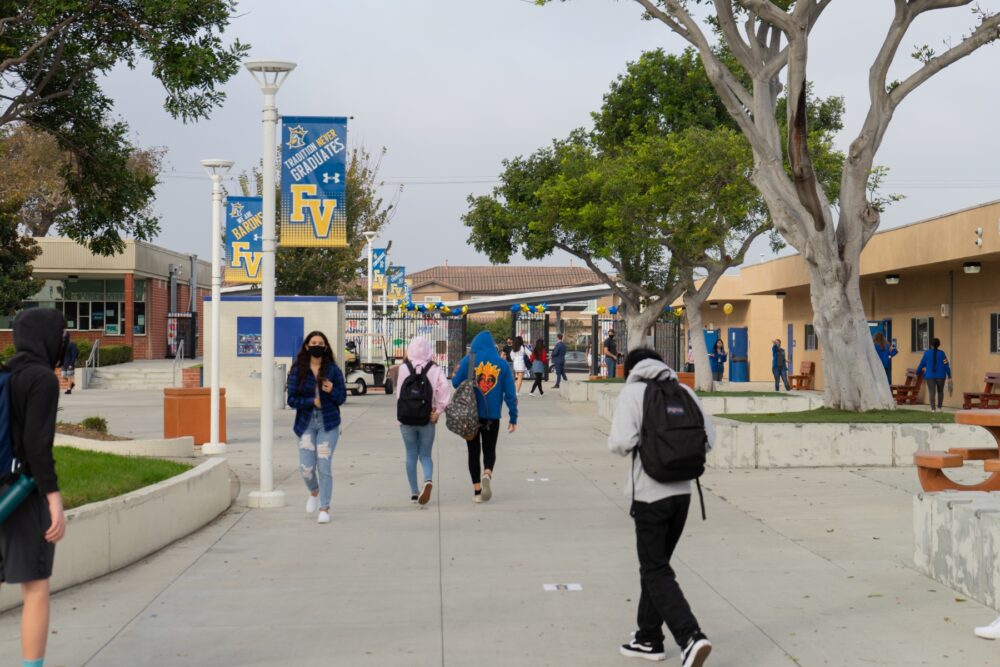
While safety precautions were followed largely without issue, there were some technical difficulties on the first day of hybrid instruction—notably, a physical network switch in the 400 halls that broke at the beginning of first period and left many social science classes without an Internet connection for most of the day.
“It was pretty much a worst-case scenario,” history teacher Cory Nelson said. “But students rolled with the punches at home and online so I think everyone understood, and it wasn’t as big of a deal as it could have been… It will only get better from here.”
Nelson added that despite today’s connectivity incident, he believes that overall FVHS is ready for in-person instruction, a sentiment echoed by Dr. Smith.
“I think because we’ve had distance learning for so long, the tech worries for the most part have been navigated,” Dr. Smith said. “Our teachers did a great job of working around hiccups [today] but I would say for the most part we were ready. The overplanning, the planning for every possibility really helped.”
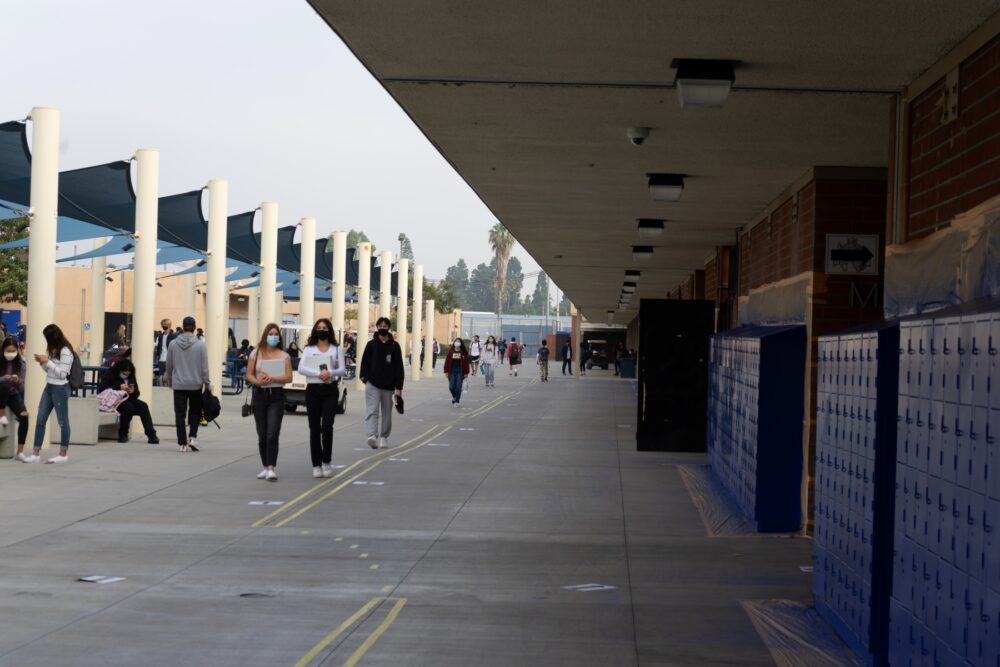
Beyond safety precautions or technology issues, one concern community members expressed leading up to the reopening date was the fact that, because HBUHSD decided to enroll fully-online (“virtual”) and hybrid students in the same classes to preserve access to courses from students’ home campuses, some hybrid students would have teachers who elected to stay online and would be taught virtually while supervised in the classroom by a substitute teacher.
“I am disappointed in the hybrid model and the possibility that there may not be a live teacher in the classroom teaching the students when we are allowed to go in person,” Marina High School parent Melissa Kimbrough wrote in a public comment submitted before the HBUHSD Board of Trustees’ September meeting. “Children that will be present in class need or want an actual teacher in the classroom with them teaching the class, not a teacher “Zooming” from their home.”
Despite these concerns, FVHS students did have classes today in which they were supervised by a substitute while their teacher instructed them remotely through Zoom.
“In a teaching environment, the teacher is the credentialed person,” Dr. Smith said. “So as long as the teacher is teaching, a staff member in our district is authorized to supervise [students] to make sure that [they] are in the classroom following those safety protocols, social distancing, everything that they need to do.”
In some cases, due to a shortage of traditional substitutes, FVHS administration and Supervision staff acted as temporary adult supervisors today.
“We had a lot of partner educators between myself as an administrator [and] assistant [Supervision staff] in our classrooms today, and more subs are coming all through the week,” Dr. Smith said. “So at some point… it’ll be a more traditional substitute supporting that online teacher.”
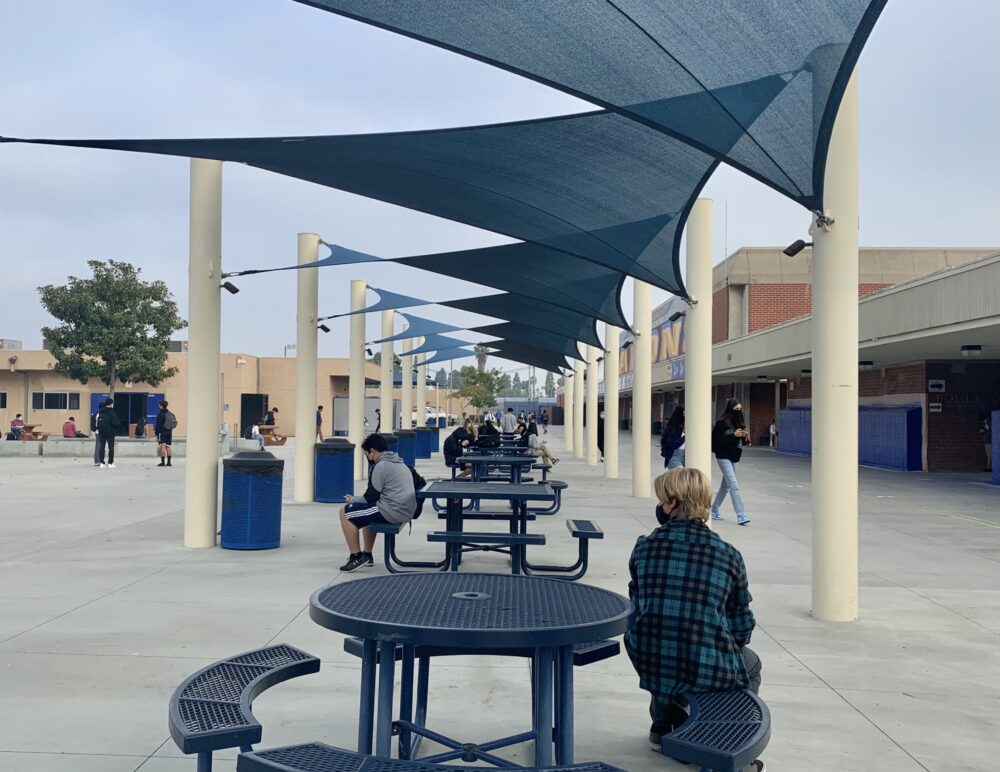
In addition to today’s somewhat nontraditional stand-ins for substitute supervisors, students and teachers in some classes were also surprised by relatively low turnout—in many classes, a fact due to students who were enrolled in hybrid instruction opting to stay at home for the first day (a choice for which there are no negative attendance repercussions, as long as students attend and engage in classes online instead).
“I kind of expected more people because I think a lot of people have been tired of being online and they just want to go back to school,” Bees said. “But I was pretty shocked at the amount of people in each classroom. There were four or five, the max was maybe eight, but there weren’t many people in class… it was just interesting.”
Math teacher Thomas Ngo said that one effect of this low in-person attendance was variability in the level of engagement that each period saw.
“[Because] the class size was super low, you get a mixed bag of energy,” Ngo said. “It really depends on that group, and one or two kids out of that group of five or six can really make the difference in the energy of the class.”
Ngo also said that another novel aspect of hybrid instruction was the complexity of in-person teachers simultaneously teaching to on-campus students and students attending virtually from home.
“I think the hardest thing was now with [one] group back, you kind of feel like you’re ignoring the group at home sometimes when you’re communicating with them in person,” Ngo said. “So yeah, that was a challenge.”
Ngo said he enjoyed seeing students walking around on campus again, however, and that he thought the first day of in-person school was a good chance to test out and get used to new technology and communication practices. Many students felt similarly happy about their first day back on campus.
“I felt that the first day of hybrid was better than I expected,” Mendoza said. “I actually really enjoyed hybrid because it was nice to be back on campus and to see my teachers and friends. It was also very nice to have a routine again and get ready for school instead of staying home all day.”
Dr. Smith said that many other students shared that opinion.
“When [I saw] the kids leave I saw a lot of smiles, and [I asked] kids how they were doing,” Dr. Smith said. “Every single kid I talked to was happy that they got to come back to school, happy that they got to see their friends and teachers in person. So I would say that by all accounts [today was] a very successful day.”
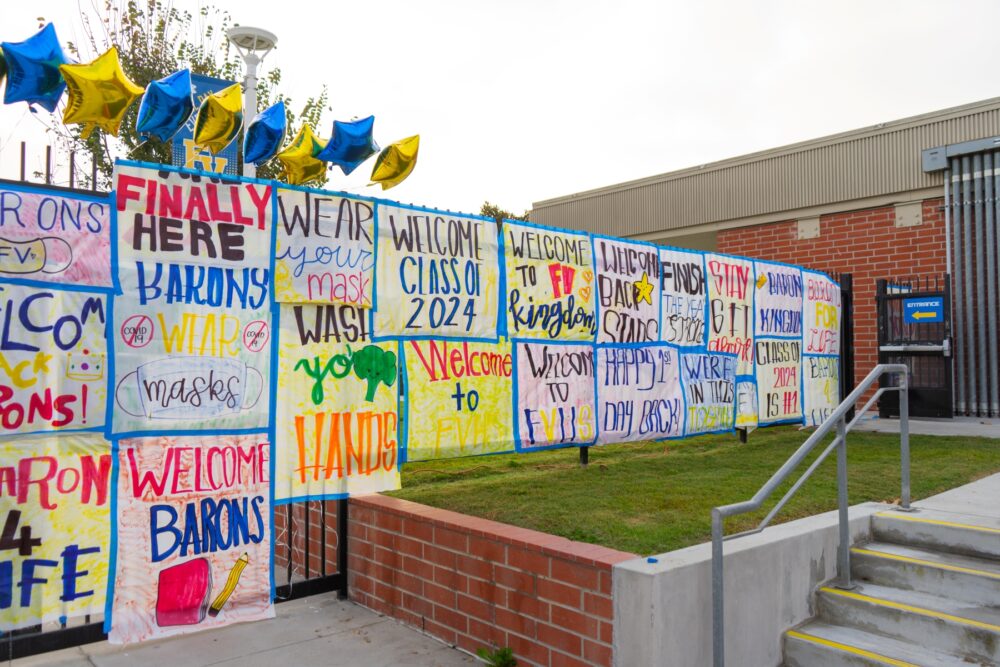
Teachers especially said they enjoyed the opportunity to meet and connect with their students in person.
“It’s been really hard for me; teaching to students who have their cameras off and just kind of talking to myself,” Nelson said. “So having students in class, being able to meet them in person and having side conversations—just real student-teacher interaction—[was good]. I think students want that as well, and so I think we’ll find a groove and I believe as long as the numbers stay where they’re at we’ll have more and more students come back to school.”
Spanish teacher Jim Diecidue agreed, saying that although adjusting to teaching in-person and on Zoom was tiring, the first day of classes on campus was better than he expected.
“It was exciting to see students and have that interaction, being together in the same classroom, being able to see people face to face,” Diecidue said. “We could joke around a little more, we could have better interaction than we could have in a Zoom classroom. So I enjoyed that. I miss that interaction with students.”
Overall, Dr. Smith says, students and families who were waiting to see how today’s return to campus played out should be reassured.
“I think they should be reassured by that success,” Dr. Smith said. “Talk to your friends that did come in person, ask them how they felt, ask them if they felt safe on campus, and that everything that they had questions about was answered… and if [students] want to make changes [regarding their instructional program], just contact our guidance specialists and we can start making adjustments.”
Karen Phan and Cate Meister contributed to this story.





